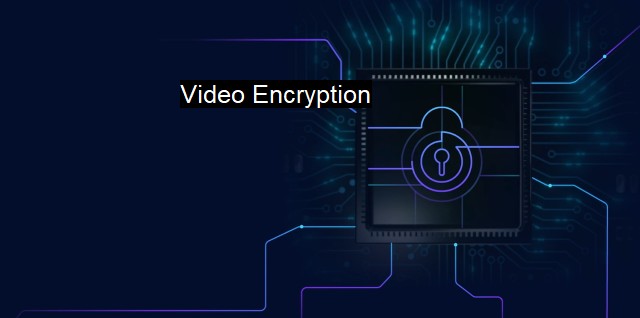What is Video Encryption?
Enhancing Cybersecurity: The Importance of Video Encryption for Protecting Sensitive Data and Intellectual Property
Video Encryption refers to the process of using algorithms and advanced computational techniques to securely encode the multimedia content of videos to prevent unauthorized and unauthenticated access. Video encryption is predominantly essential in cybersecurity due to the vulnerability of unencrypted videos and ease of data theft from these videos while they're being shared and distributed over networks. Consequently, video encryption plays a vital role in ensuring the confidentiality, authenticity, and integrity of video content transmitted over multiple platforms.Video encryption operates under the fundamentals of cryptography. Cryptography is a method of protecting information by transforming it into an unreadable format—called cipher text—which can only be deciphered by those who possess a unique decryption key. With the tremendous growth in video usage and streaming platforms, video encryption techniques used in the world of cybersecurity and antivirus solutions are increasingly crucial in the preservation of multimedia data confidentiality.
Different encryption methods are utilized when encrypting video data. One such method is crypto systems based on symmetric encryption algorithms, such as the Advanced Encryption Standard (AES). Here, the encryption and decryption key are identical. This method is used for the bulk encryption of data due to its fast computational speed and low resource usage compared to asymmetric encryption.
Another method is based on asymmetric algorithms like the RSA (Rivest-Shamir-Adleman). Unlike symmetric encryption, this method uses different keys— public and private—for encryption and decryption. Asymmetric encryption is implemented when sharing the encryption keys is impractical or impossible.
Video encryption's scope is widely embedded in copyright protection. Various video distribution platforms, such as Netflix and Amazon Prime, harness video encryption to shield their content from privacy, ensuring only authenticated and paid users can view the content. This Digital Rights Management (DRM) service offers protection against piracy, particularly for high-end commercial and confidential video files, preserving the digital content provider's revenues.
Modern antivirus solutions are incorporating video encryption mechanisms to prevent malware or spyware's potential intrusion that might exploit unencrypted video data. The use of video encryption not only offers an added security layer to the data but also makes the process of unauthorized access considerably challenging for cybercriminals.
Video encryption is also significant in securing video surveillance systems. In a myriad of situations, surveillance footage can consist of sensitive and incriminating evidence. Therefore, using encrypted video streams ensures only individuals equipped with proper decryption keys can view or tamper with the evidence. This level of security is imperative across multiple industries, particularly in Banking, Retail, Logistics, and Defense sectors.
Video conferencing, especially during the ongoing global pandemic situation, has seen an escalating rise in usage. Platforms like Zoom, Skype, and Google Meet use video encryption to provide secure virtual communication. Whether it’s daily work briefings, confidential executive meetings, digital education, or telemedicine sessions, video encryption ensures the safeguarding of sensitive information against unwanted intrusion, providing it only to authenticated individuals.
Video encryption serves an essential role of utmost importance in the realm of cybersecurity and antivirus solutions. It continues to be a crucial defense measure, spanning multiple platforms, enhancing privacy, and ensuring the integrity of digital content. As constantly evolving cyberspace technologies continue to present new threats, video encryption is projected to be a significant area for ongoing development and innovation.

Video Encryption FAQs
What is video encryption and why is it important for cybersecurity?
Video encryption is the process of transforming a video file into a coded language that can only be deciphered with a decryption key. Encryption is important for cybersecurity because it prevents unauthorized access to video files, keeping them safe from hackers, malware, and other cyber threats.Which types of video encryption are commonly used to protect against antivirus threats?
Advanced Encryption Standard (AES) and Data Encryption Standard (DES) are the most commonly used encryption types for video files. These encryption types provide a high level of security and are used by many antivirus software programs to protect against cyber attacks.Does video encryption slow down video playback or affect the quality of video files?
Encryption can slow down video playback, depending on the strength of the encryption and the processing power of the device. However, modern encryption techniques have been optimized to minimize any potential performance issues. Additionally, video encryption does not affect the quality of video files.What are the benefits of using video encryption in antivirus software?
The benefits of using video encryption in antivirus software include protecting sensitive video files from being accessed by unauthorized users, preventing malware from infecting video files, and providing a higher level of security to ensure that video files remain secure even if other security measures are compromised.| | A | | | B | | | C | | | D | | | E | | | F | | | G | | | H | | | I | | | J | | | K | | | L | | | M | |
| | N | | | O | | | P | | | Q | | | R | | | S | | | T | | | U | | | V | | | W | | | X | | | Y | | | Z | |
| | 1 | | | 2 | | | 3 | | | 4 | | | 7 | | | 8 | | |||||||